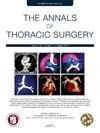心血管重症监护病房夜间人员配备对抢救失败率和收入的影响。
IF 3.6
2区 医学
Q1 CARDIAC & CARDIOVASCULAR SYSTEMS
引用次数: 0
摘要
背景:抢救失败(FTR)是术后并发症后的死亡率。我们研究了心脏手术后夜间重症监护人员配置和 FTR 的影响:我们纳入了接受心脏手术的患者,对 FTR(胸外科医师协会定义的主要并发症患者的死亡率)进行了研究。时代 2(7/2021-6/2023)和时代 1(7/2016-6/2021)的特点分别是有和没有夜间重症监护人员。比较了并发症和 FTR 率、重症监护室每日人口普查和相对价值单位(RVUs):在 5654 名患者中,第二时代的 17%(284/1661)患者至少出现了一种并发症,而第一时代的这一比例为 19%(769/3993)(P=0.057)。在出现并发症的患者中,第二代的 FTR 发生率为 8%(22/284),而第一代为 19%(145/769)(PConclusions:夜间重症监护病房的覆盖降低了心脏手术后患者的 FTR 发生率,而并发症发生率和重症监护病房人数保持稳定。此外,RVUs 的增加表明这是一种经济上可持续的模式。本文章由计算机程序翻译,如有差异,请以英文原文为准。
Impact of Nighttime Cardiovascular Intensive Care Unit Staffing on Failure to Rescue and Revenue
Background
Failure to rescue (FTR) is mortality after at least 1 postoperative complication. We investigated the impact of nighttime intensivist staffing and FTR after cardiac surgery.
Methods
We included patients who underwent cardiac surgery to examine FTR, defined as mortality in those who experienced a Society of Thoracic Surgeons–defined major complication. Era 2 (July 2021-June 2023) and era 1 (July 2016-June 2021) were characterized by the presence and absence of nighttime intensivists staffing, respectively. Complications and FTR rates, daily intensive care unit (ICU) census, and relative value units (RVUs) were compared.
Results
Among 5654 patients, 17% (284 of 1661) in era 2 had at least 1 complication vs 19% (769 of 3993) in era 1 (P = .057). Among patients with complications, FTR incidence was 8% (22 of 284) in era 2 vs 19% (145 of 769) in era 1 (P < .001). The daily average ICU census did not change (12.3 in era 2 vs 12.0 in era 1, P = .386). Comparing mean annual RVUs during the 2 fiscal years in era 2 (35,613 per year) with what would have been expected based on the last 2 fiscal years of era 1 (26,744 per year), a significant increase of +8870 per year was observed (95% CI, 3876-13,863, P = .028). Multivariable analyses found no difference in the risk of major complications comparing era 2 vs era 1 (odds ratio, 1.04; 95% CI, 0.89-1.23; P = .602), and a 59% reduction in FTR risk in era 2 vs era 1 (odds ratio, 0.41; 95% CI, 0.25-0.67; P < .001).
Conclusions
Nighttime ICU coverage reduced FTR rates in postcardiotomy patients while complication rates and ICU census remained stable. Furthermore, the increase in RVUs suggested an economically sustainable model.
求助全文
通过发布文献求助,成功后即可免费获取论文全文。
去求助
来源期刊

Annals of Thoracic Surgery
医学-呼吸系统
CiteScore
6.40
自引率
13.00%
发文量
1235
审稿时长
42 days
期刊介绍:
The mission of The Annals of Thoracic Surgery is to promote scholarship in cardiothoracic surgery patient care, clinical practice, research, education, and policy. As the official journal of two of the largest American associations in its specialty, this leading monthly enjoys outstanding editorial leadership and maintains rigorous selection standards.
The Annals of Thoracic Surgery features:
• Full-length original articles on clinical advances, current surgical methods, and controversial topics and techniques
• New Technology articles
• Case reports
• "How-to-do-it" features
• Reviews of current literature
• Supplements on symposia
• Commentary pieces and correspondence
• CME
• Online-only case reports, "how-to-do-its", and images in cardiothoracic surgery.
An authoritative, clinically oriented, comprehensive resource, The Annals of Thoracic Surgery is committed to providing a place for all thoracic surgeons to relate experiences which will help improve patient care.
 求助内容:
求助内容: 应助结果提醒方式:
应助结果提醒方式:


